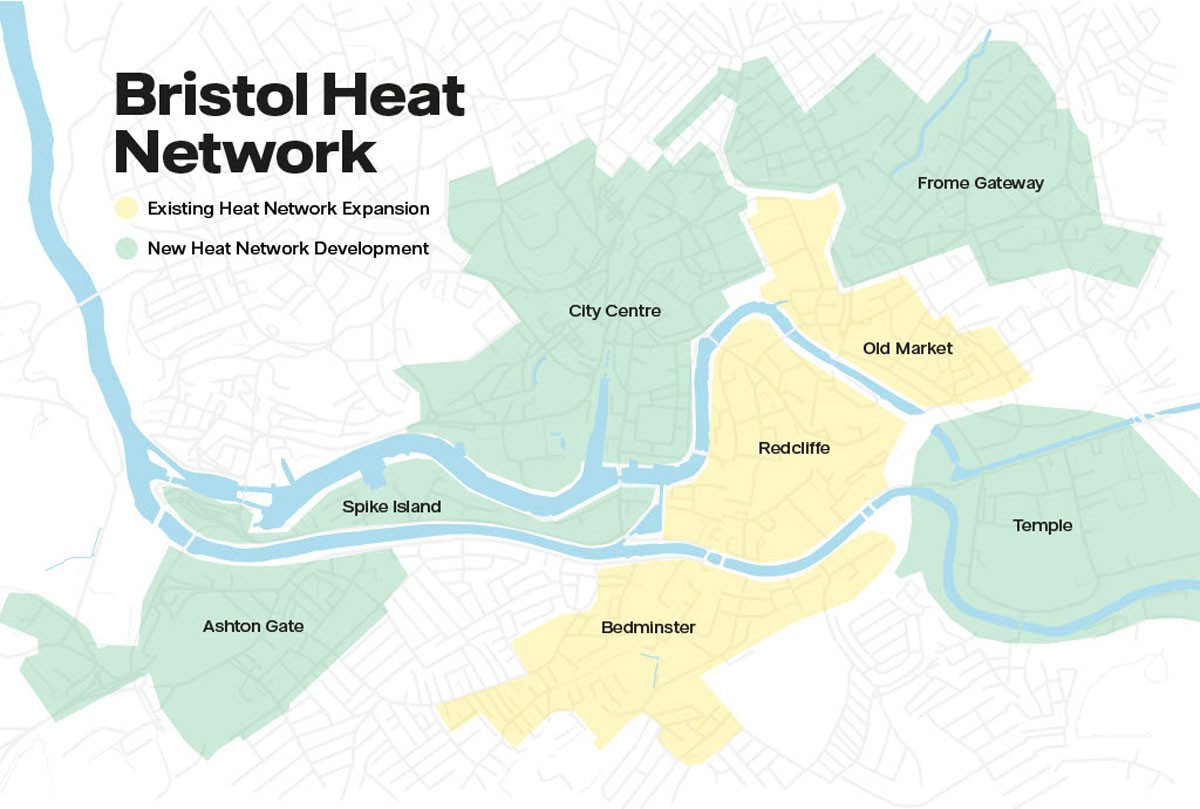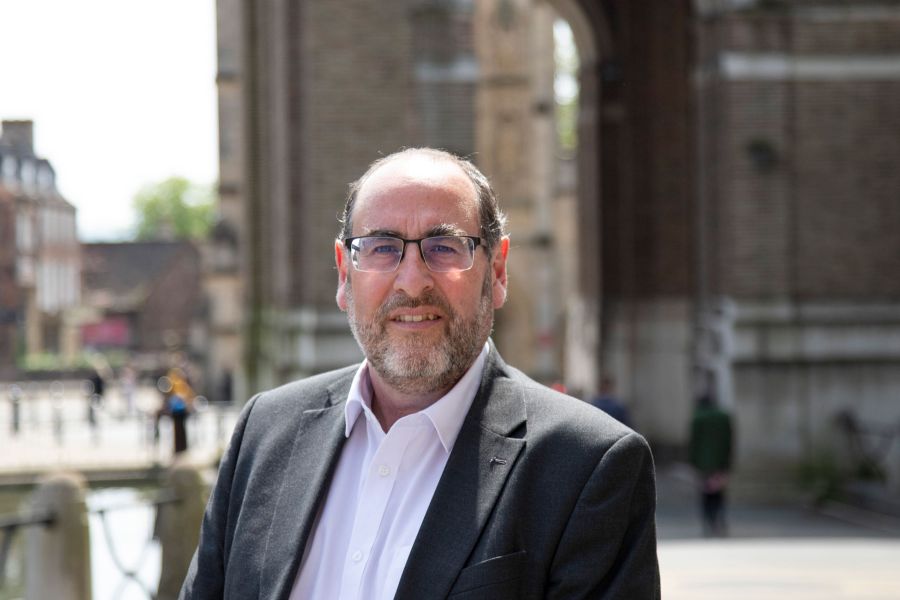Decarbonising Bristol, one heat network connection at a time
As Bristol strives to reduce its carbon footprint, the ambitious plan to connect city centre homes and workspaces to a series of fossil-free heat networks advanced in 2023.
But what will it mean for the property sector?
Nobody can accuse the people behind Bristol City Leap of being unambitious in their aspirations. Their website boldly announces that, “Within five years, over 120 GWh of low carbon heat will be delivered to customers in Bristol through over £200 million of investment into high-quality, long-term infrastructure across the city.”
That, they say, is only the start. Over the next 20 years, as we set our sights on a carbon-neutral future, the joint venture between Bristol City Council, Ameresco and their subcontractor Vattenfall Heat UK aims to deliver in excess of £1 billion of investment into Bristol’s energy system.
Already two city centre heat networks are in operation at Redcliffe and Old Market, with a third under construction in Bedminster. These networks now supply over 15 GWh of heat per year across 14 operational connections. Ultimately, the partnership’s intention is to create a single interconnected, city-wide Bristol Heat Network.
The concept of heat networks is well tested elsewhere in the world, and even the UK had a toe in the water before the “dash to gas” refocussed our direction of travel.
But Bristol leads the way nationally… driven by Bristol City Council declaring a climate emergency in 2018 and pledging to make the city carbon neutral by 2030.
Meeting that target, it was estimated, would require tens of thousands of buildings to replace their gas boilers with heat pumps of some sort (air, ground or water). However, not only is it unfeasible for many buildings to have their own heat pump, but a network can theoretically deliver greater economies of scale – as well as providing a neater and more compact technical solution in the form of a plate heat exchanger within individual buildings.
Bristol City Leap also has more cards up its sleeve: they recognise the role that other forms of sustainable energy can play in achieving the carbon targets, and are advising on complementary sources– such as solar– as part of their “one stop, turnkey” offer to building owners.

So what is the story behind Bristol City Leap, and how can the property sector play its part in making Bristol carbon neutral?
The story so far
David White, the partnership’s Operations Director, has been involved in the project since it was kicked off in 2016 by Bristol City Council, where he led the energy team. “We’ve taken a few years to get here,” he concedes. “Due to the innovative nature of the partnership, we didn’t have a blueprint to follow, meaning that it’s taken extra time and resources to make certain that we have the right formula for Bristol.
“However, the partnership with Ameresco and Vattenfall Heat UK is now giving us the technical expertise and financial backing to take action on decarbonisation at a city scale – whilst also providing a replicable approach that other cities and regions can follow.”
The partnership’s confidence is predicated on the fact that meeting the city’s ambitious carbon targets will be difficult without very bold action within the built environment – which is responsible for around a quarter of greenhouse gas emissions.
In the words of Jon Sankey, Head of Business Development at Vattenfall Heat UK – Bristol, “There is a huge amount of change on the horizon – driven by national policy – and particularly relevant to the property sector are the requirements for buildings to meet higher standards of sustainability.
“The BPAA membership is one of the core constituents in terms of our target markets as advisors to landlords and developers who may well not be in Bristol, and so are unaware of what is now becoming available here.”
Bristol, he maintains, will be years ahead of the curve in meeting national ambitions on sustainability – and that will prove attractive to investors, tenants and landlords keen to burnish their ESG credentials.
Adds David: “Simply put, we have to decarbonise. The science is pretty clear now. The property sector is adopting ambitious ESG targets in response to that, and making public commitments. But how is this going to happen?
“Where you have high heat density, as you do in the city centre, and you’re faced with the call to come off gas, what are you going to do? Either put in a heat pump or connect to a heat network. Both require you to do something to your building fabric. And to make either work to maximum effect, you need to push down demand within the building – which is something else we can assist with.”
“Our solution,” says Jon, “can remove the need to have your own heat pump and takes away maintenance costs. The technology that sits within each individual building is incredibly simple: it’s just a heat plate exchanger, which we own and operate. So all of the technical stuff is centralised and offloaded.
“That’s where scale and buy-in are important for any heat network to operate effectively. You need certainty of demand. There are lots of variables in determining how many users you need to make it viable, but if you take Canon’s Marsh, an area we’ll be looking at to supply, we’re aiming to connect almost every building – although some won’t be perfectly compatible from day one.
“But it’s not just about heat. Bristol City Leap can offer a turnkey energy solution for buildings and developments through its partners and other technologies.”


First targets
That’s an interesting point,” replies Jon. “The reason we’ve managed to get to the point we are now in Bristol is that we’ve had a planning policy in place that requires new builds to connect to the network if there is one available. That has enabled the construction of networks in areas where there’s lots of new development – Old Market, around Avon Street and Redcliffe. We’re about to start in the Temple Quarter area.
“At city level, having live projects generating revenue enables us to prove demand to our parent company; and that, if we built more networks, more buildings will connect. That would enable us to branch out into areas where there are predominantly existing buildings rather than new ones.”
The specific energy source Bristol City Leap will use will depend upon what’s available in each area, Jon says.
For instance, the water source heat pump that we operate in Castle Park is extracting heat from the floating harbour, which is then pumped around to buildings nearby.
We have other technologies available – including air source heat pumps – and are already using those for the Redcliffe network. Over time, we’ll be using energy sourced from waste too.”
Recycling excess heat from buildings is another option – for instance, the new University campus computing centre could export enough heat for an estimated 1,000 homes.
“As we build out,” adds Jon, “we’ll be looking to find more potential sources of waste energy.”
Costing the carbon-free route
“Bristol City Leap is taking a strategic approach to the decarbonising of Bristol,” says David, “but we can’t achieve that on our own. Loads of organisations have to get involved, including building owners and tenants… but how do they do that with the least disruption to their everyday operations? We can help with that, and there’s value in there for everybody.”
“As well as offering to take buildings well beyond the EPC B ratings required for 2030,” adds Jon. “we commit in our contracts that our heat connection charges and tariffs will be in line with other low carbon energy sources.
“We can also offer a solution for buildings that will be incompatible with fitting heat pumps – the Cathedral, for instance, for heritage reasons. Some buildings simply won’t have the space to house their own heat pump. A heat exchanger takes up no more room than the gas boiler it will be replacing.”
Next steps
So what would success over the next couple of years look like?
“We want to start conversations now with agents where lease events or sales are coming up,” says Jon. “We’re happy to undertake an assessment on a potential pathway to using the heat network, so that when agents are marketing a building or planning a move they can pass on that information to potential buyers or tenants.”
A number of agents are expressing concern about advising clients to prepare their buildings for a technology that might not reach them for some time to come. How can Bristol City Leap square that particular circle?
“We recognise that it’s a chicken and egg situation,” concludes Jon. “Understandably there’s a bit of scepticism. But early conversations will allow the property sector and Bristol City Leap to work together for the benefit of both – and release a vast amount of social value as well as economic benefit.”



